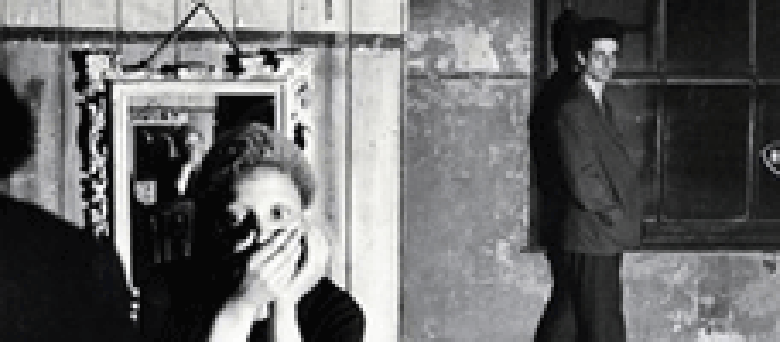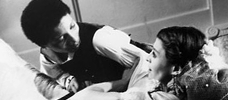Reviews
Sally Potter
UK, 1979
Credits
Review by Jenny Jediny
Posted on 17 February 2008
Source BFI 16mm print
Categories The Lyricism of Sally Potter
While I’m barely familiar with Mimi, the doomed heroine of La Bohème, this variation of female character is all too recognizable; whether in an opera or a novel, all too often female characters are victims, either of unrequited love, some sort of terminal illness, and/or display an inability to take control of their often unfortunate circumstances. Mimi is a character formed from this recognizable female mold, and in Thriller, Potter not only deconstructs her character in La Bohème, but the role of women in popular art as well, arguing against these stereotypes while also attempting to understand their endurance.
La Bohème tells the simple story of a group of male friends in 19th century Paris, one of whom, Rodolfo, falls in love with a seamstress, the aforementioned Mimi. Mimi’s eventual illness (the ever reliable consumption) drives the lovers apart, and she inevitably dies in Rodolfo’s arms. While setting up the opera’s action, Potter establishes how common this story has become (certainly in cinema, it’s recognizable in films ranging from Love Story to Moulin Rouge), and in some sense, how ludicrous it seems when out of context. When not caught up in an accompanying score or other aesthetically pleasing detail, the bare bones of the plot practically insist that the woman must die to validate an unrequited romantic glory.
While placing Puccini’s famous opera as the fulcrum of her argument, Potter borrows substantially from recognizable films, while altering the context of her references. As implied by its title, Thriller utilizes signature traits of the horror genre: murder, an ear-piercing soundtrack, and women in danger. However, the soundtrack is lifted from Hitchcock’s Psycho, specifically the violin screech of the shower scene that Potter intersperses throughout the film for her own “murder” scenes. Employing a voice-over, Potter’s protagonist identifies with the fictional character of Mimi, describing Mimi’s death as her own. The repetitive use of such familiar musical chords hones the questions proposed by the narrator, on why women are so frequently the victim of the knife, or of incurable illnesses that merely accentuate the plot or the men around them. Potter approaches these women as instruments, examining the notion that rather than placing them at the story’s forefront or developing their characters beyond two-dimensions, they are used as narrative tools by writers and directors alike.
A mélange of filmmaking styles, Thriller cuts between still photographs (á la Chris Marker’s La Jetée) and avant-garde technique evokes the early work of Maya Deren. The narrator often gazes upon herself in a mirror, visualizing her doppelganger, Mimi, while ruminating on how she might not have actually died, instead reliving the same life, the same role repeatedly. In displacing any narrative fluidity, Thriller provokes, requiring the viewer question along with our protagonist. One of the film’s strongest inquisitions connects history with art form, discussing Mimi’s fate if she had in fact survived, and how she might have lived her life out as a factory seamstress, keeping in line with the fate of much of the nineteenth century working class. Arguably, Mimi would not be a “proper” subject for such a love story as La Bohème in this circumstance, as popular fiction (in any form) rarely includes not only the realistic, but also the old—old women are certainly uncommon subjects in film, let alone viable love interests.
Thriller is a disquieting, beautiful film; the blend of formats and techniques retains a hypnotic power, and the questions raised have not lost their power or their relevancy. While other artists have tackled similar ideas regarding female identity years after its debut, Thriller remains a landmark in feminist filmmaking, as Potter’s foray into cinema is a memorable leap that leaves Mimi with far more life than Puccini ever intended for her. The film’s fade out to black, accompanied by Mimi’s eerie laughter, remains as ambiguous as it is vexing—is she laughing at us or with us? Potter would prefer we decipher this question on our own.
More The Lyricism of Sally Potter
We don’t do comments anymore, but you may contact us here or find us on Twitter or Facebook.








